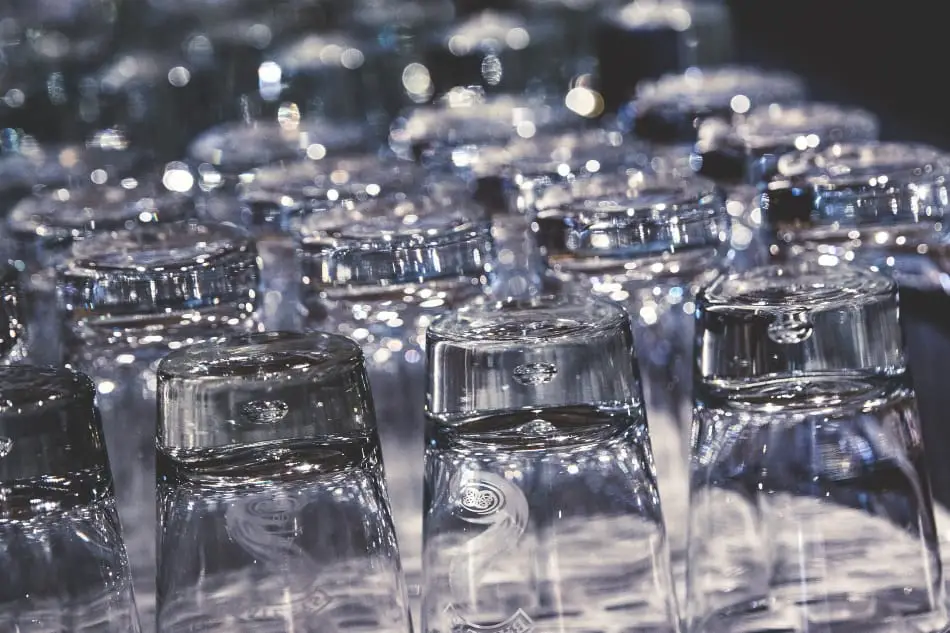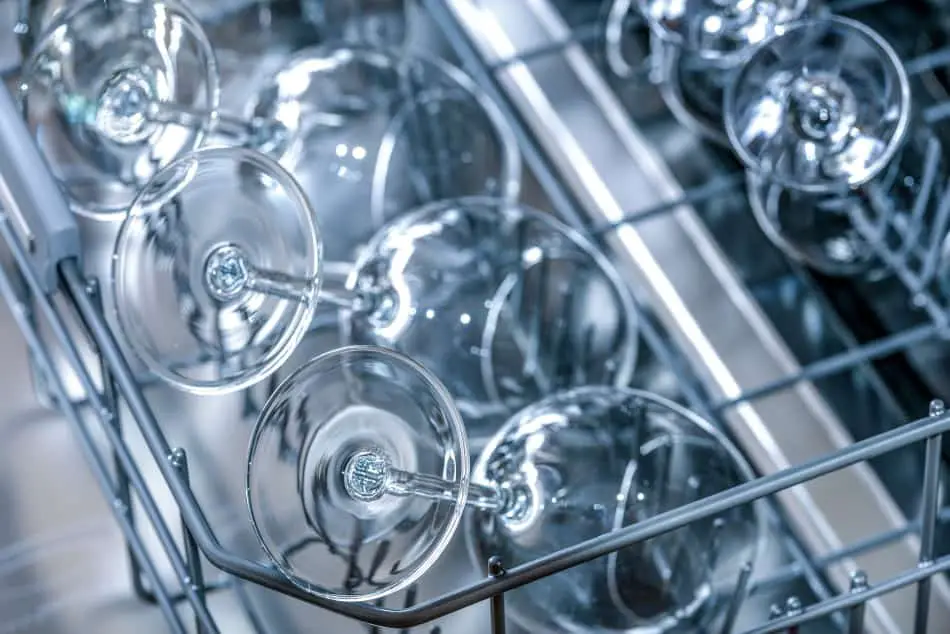It’s important to know how to clean whiskey glasses properly because stains or residue from soap or previous pours can cling to the glass and alter the appearance, aromas and flavors of your whiskey. They can even create a haze in your whiskey glasses that makes them look cloudy and permanently damage them.
That’s why I created this guide to cleaning whiskey glasses properly. Now you can have clean whiskey glasses that will keep their sparkle and won’t contaminate your drink.
Note: This guide applies to all types of whiskey glasses. For a more detailed explanation of them, see this in-depth article I wrote here.

When To Clean Your Whiskey Glasses
Ideally, you should clean a whiskey glass each time you pour a different whiskey from the one it previously held. (Unless of course, you’re going to be using a different whiskey glass too.)
You should also clean your whiskey glasses soon after you’ve finished using them. Leaving them until the next day may make them smell great (because more of the alcohol has evaporated, leaving you with only the smell of the whiskey), but it’s also given the remaining particles time to become more deeply embedded in the microscopic pores and crevices of the glass.
Whiskey glasses that are left unused for long periods of time should be washed yearly, even if they’re stored away in a closed cabinet. That’s because dust can still get to them and cause etching in the glass, which damages them permanently.
How To Clean Your Whiskey Glasses by Hand
Cleaning your whiskey glasses by hand allows you to avoid any damage that could occur from cleaning them in the dishwasher. It also allows you to control the amount of water and residue-leaving soap you use and to clean your whiskey glasses more thoroughly. Here’s exactly what to do.
1. Wash with Warm Water and Minimal Detergent
Wash your whiskey glasses under warm water and if you can without using any detergent. Since the whole problem, when cleaning whiskey glasses, is the remaining residue, it’s a good idea not to add another source of them. If the glass is still dirty or has difficult to remove stains, you may need to use hot water.
If that’s still not enough, then you’ll have to use soap as you don’t want residue from the whiskey to remain on the glass either. Use as small amount of unscented, mild liquid soap that doesn’t create glass-clinging suds, as possible.
2. Scrub Gently with A Soft Brush or Sponge
Gently scrub your whiskey glasses both inside and out with a soft brush or sponge. Do not use an abrasive scrubbing sponge as they will permanently scratch your whiskey glasses.
Soft bottle brushes are best because they can reach places your fingers can’t, like the bottom of the taller highball glass or the sides of the wider nosing glass.
You can use any bottle brush as long as it’s soft, but I recommend the CairnCleaner which you can find on Amazon here .
.

Scrub your whiskey glasses in a circular motion, starting from the bottom and working your way up to the top.
3. Soak in Vinegar to Remove Any Existing Haze
If your whiskey glasses already have a haze-like film on them that makes them cloudy then, as long as it’s caused by unrinsed soap or the minerals of hard water that hardens and builds up on the surface of the glass, it can be removed.
It may come off with soap but if not, you’ll need to soak your whiskey glasses in vinegar.
To do that, place a bottle of distilled white vinegar into a bowl of simmering water for about 5 – 10 minutes to warm. Next, pour the vinegar into a plastic tub and then submerge your whiskey glass in it. Alternatively, you can pour the vinegar directly into your whiskey glass. Either way, let your whiskey glass soak for an hour and then try scrubbing it (gently) again.
If that doesn’t work, then it means that the haze was probably caused by cleaning with soft water and alkaline dish detergents at the same time, so it has become etched into your whiskey glasses and can’t be removed. Now you know not to do that again. Should you decide to replace them, see this article I wrote about the best whiskey glasses out there first, which you can find here.
4. Rinse Thoroughly with Warm Water
If you’ve used soap (or vinegar), then it’s important that you rinse your whiskey glasses thoroughly. You don’t want to leave any soapy residue as it will cling to the glass and damage it and your whiskey.
Use warm water to rinse your whiskey glasses, not cold. It’s important that the temperature of the water when rinsing is the same as the temperature of the water when washing, as extreme changes can cause cracks in the glass.
5. Dry Immediately with A Clean, Lint-Free Towel
Dry your whiskey glasses immediately as this keeps them clear and shiny. Don’t air dry them as this will leave water spots on the glass.
Use a lint-free towel or microfiber cloth so you don’t leave any materials on the glass that get in the way of it sparkling brilliantly or your view of the whiskey.
Make sure the towel is clean and fresh because the last thing you want, after getting rid of any residue from the whiskey and the soap to ensure it doesn’t negatively affect the next whiskey you pour, is to add the smells and dirt of a less-than-clean and fresh dish drying towel.
To give your whiskey glasses an extra shine, hold them over boiling water (though not too close) until the inside steams up, and polish them with a microfiber cloth.
How To Clean Your Whiskey Glasses in The Dishwasher

Cleaning your whiskey glasses in the dishwasher is certainly easier than cleaning them by hand, especially if you have a lot of them. Here’s exactly what to do.
1. Check They’re Dishwasher Safe
A lot of whiskey glasses can be cleaned in the dishwasher, but it’s best to double check with each manufacturer. Even if you do get the all-clear, you need to understand what dishwasher safe actually means. And what it doesn’t.
Dishwasher safe means that the whiskey glasses can withstand high heat, wash sprays and detergent without damage, but it doesn’t mean they can withstand a collision with another piece of crockery that has been knocked out of its place in the rack by the force of the dishwasher’s water jets.
More importantly, although cleaning in a dishwasher may cause no visible damage, the harsh spray of its water jets and the abrasive detergents can make minuscule scratches in the whiskey glasses that will, over time, dull their clarity. Which is why many manufacturers say their whiskey glasses are dishwasher safe, but they recommend that you wash them by hand.
This means that you have several options:
- Never use a dishwasher to clean your whiskey glasses.
- Always use a dishwasher to clean your whiskey glasses and not mind that they will eventually lose their clarity.
- Occasionally use a dishwasher to clean your whiskey glasses so it takes longer for them to lose their clarity.
- Only use a dishwasher to clean those whiskey glasses that you don’t mind being damaged, and hand wash those that are more valuable.
If you do decide to use a dishwasher to clean your whiskey glasses, mitigate these and any other problems by following the rest of these instructions.
2. Load Them onto The Stemware Rack
Load your whiskey glasses onto the top rack, also known as the stemware rack, where they’ll move less and so are less likely to become damaged. If your whiskey glass is tall, see if your dishwasher allows you to adjust the position of the upper rack to accommodate them.
Ensure your whiskey glasses don’t touch any other items in the dishwasher or each other, as this will cause them to become scratched. The more space between your whiskey glasses and anything else in the dishwasher, the better.
3. Avoid Using a Harsh or A Lot of Detergent
For reasons already mentioned, you should avoid using a harsh or a lot of detergent. This means not washing your whiskey glasses with anything so dirty that it won’t be cleaned without stronger or more detergent.
4. Select Your Dishwasher’s Glass Setting
When cleaning your whiskey glasses in the dishwasher, it’s best to use the glass setting because it’s a gentler program designed to protect glass, although stronger whiskey glasses can be cleaned using a normal wash cycle.
5. Use The Air Dry and Not the Heat Dry Setting
Do not use the heat dry setting as high temperatures will cause your whiskey glasses to become cloudy. Instead, let your whiskey glasses air dry, or even better, hand dry and polish them as above to prevent water spots and keep them clear and shiny.
